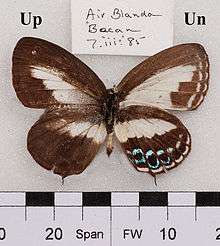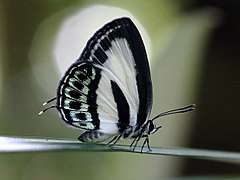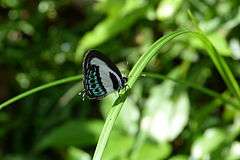Nacaduba cyanea
| Nacaduba cyanea | |
|---|---|
.jpg) | |
 | |
| Scientific classification | |
| Kingdom: | Animalia |
| Clade: | Euarthropoda |
| Class: | Insecta |
| Order: | Lepidoptera |
| Family: | Lycaenidae |
| Genus: | Nacaduba |
| Species: | N. cyanea |
| Binomial name | |
| Nacaduba cyanea | |
| Subspecies | |
|
See text | |
| Synonyms | |
| |
Nacaduba cyanea, the tailed green-banded line-blue, is a species of butterfly in the family Lycaenidae, and formerly considered a member of the genus Danis. It is found in the Indonesia (Irian Jaya, Maluku), Papua New Guinea, the Solomon Islands and Australia (Queensland).[2]
The wingspan is about 30 mm. Adult males are blue with a dark brown wing margin. There is a pale blue to white patch on the hindwing. Females are white with a broad black border and a row of blue edged black spots.[3]
The larvae feed on Entada phaseoloides and Entada scandens. They are bright green with pale brown head. The larvae are attended by ants of the genus Anonychomyrma. Pupation takes place in a brown pupa with dark markings
Gallery
 Green-banded line-blue in Cairns
Green-banded line-blue in Cairns Green-banded line-blue at Mission Beach
Green-banded line-blue at Mission Beach
Subspecies
- N. c. arinia (Oberthür, 1878) (Torres Straits Islands, Cooktown to Ingham) - tailed green-banded blue
- N. c. carissima (Grose-Smith & Kirby, 1895) (Timor)
- N. c. chromia (Druce, 1891) (northern Solomons)
- N. c. cyanea
- N. c. epicoritus (Boisduval, 1832) (Waigeu, West Irian)
- N. c. hamilcar (Grose-Smith, 1894) (Admiralty Islands, Bismarck Archipelago)
- N. c. illustris (Röber, 1886) (Kai Island)
- N. c. manto (Grose-Smith & Kirby, 1896) (south-eastern New Guinea, Papua New Guinea)
- N. c. obiana (Fruhstorfer, 1915) (Obi)
- N. c. pindus (C. & R. Felder, [1865]) (Bachan, Halmahera, Ternate, Salawati, New Guinea)
- N. c. rosselana (Bethune-Baker, 1908) (Louisade Archipelago)
- N. c. smaragdus (Druce & Bethune-Baker, 1893) (Wetar, Kai)
- N. c. sperchius (C. & R. Felder, 1860) (Waigeu, Misool, Salawati, W.West Irian)
- N. c. stephani (Grose-Smith & Kirby, 1896) (New Guinea)
References
This article is issued from
Wikipedia.
The text is licensed under Creative Commons - Attribution - Sharealike.
Additional terms may apply for the media files.